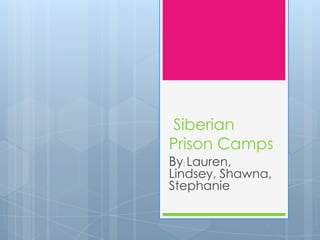
Siberian prison camps slideshow
- 1. Siberian Prison Camps By: Lauren, Lindsey, Shawna, Stephanie
- 2. Siberia Map
- 3. What are prison camps? A prison camp is a place where people are taken against their will and held prisoner in inhuman conditions. First Siberian Prison camps were set up after the October Revolution in 1917 Used in civil war from 1918 to 1920 From 1918 through the mid-1950’s, millions of innocent Soviet citizens, criminals, and political opponents of Stalin were sent to these labor camps and treated as slaves.
- 4. What is a Gulag? Gulag is an acronym for Chief Administration of Correctional Labor Camps A system of labor camps maintained in the Soviet Union from 1930 to 1955 in which as many as 20 million people died in the camps and more than 40 million were repressed By 1952, these camps had about 12 million people living in them
- 5. Different Types of Camps Sharashka-secret research laboratories where arrested/convicted scientists developed new technologies Psikhushka-forced medical treatment in psychiatric imprisonment; break down political opponents
- 6. Living in the prison camps Life was brutal and being there was a death sentence for most people. Competed with others for access of life’s necessities Lots of violence! During non-working hours, prisoners would live in a camp zone surrounded by fence or barbed wire Overlooked by armed guards in watch towers
- 7. Forced Labor in the Camps Sentenced to hard labor Work done: built dams, canals, factories, worked in mines & cut timber Some prisoners helped build the Trans- Siberian Railway
- 8. Men Cutting Down Timber
- 9. The Trans-Siberian Railway 1891-1916 Built mostly by convict labor The Trans-Siberian Railway was the largest in the world based on construction sped, length, and difficulty of building. Goes all the way across Russia Today it crosses 10 different time zones
- 10. The Trans- Siberian Railway
- 11. Benefits for Stalin Without slaves the construction of railroads, factories, and the mining of gold and coal would not have happened Therefore Stalin’s industrial revolution would not fall short of its goal
- 12. Food Rations Received food based on how much work they did If they did not fulfill their duty, they received even less food Barely enough food for survival
- 13. Pictures of Food Rations/ Utensils
- 14. Punishment If you did not work hard enough, they would be Whipped to death Chained up in an underground black hole 45 lb. wood chained to them for several years Once sentence was completed, the punishment was taken off
- 16. One Prison Camp- Kolyma There were 5,000 prisoners and 436 of them were Polish 7 to 11 men died daily due to: Famine Exhaustion Beatings at work Frost/ thermic shock
- 17. Where is Kolyma?
- 18. Discussion Questions If you knew you were heading to a prison camp what would be your first plan of action? Would you try to escape or would you fear the consequences? If you were in a prison camp with your family, would you put yourself in front of them when it comes to food distribution?
- 19. Discussion Questions cont. What does Gulag mean? What are Psikhushkas? What is your interpretation of the camp? What would you compare it too? Based on your previous knowledge what sounds worse Nazi or Siberian camps?